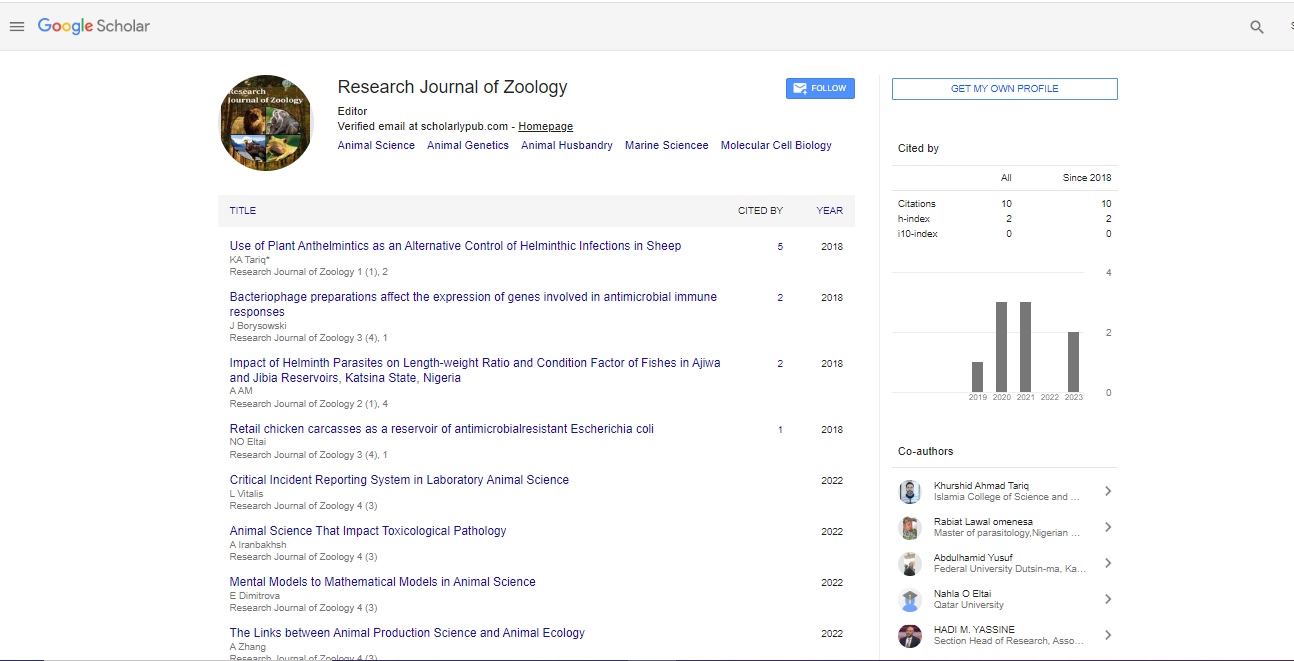Perspective, Res J Zool Vol: 5 Issue: 1
Types of Cytogenetic Techniques and Its Function
Chin Fing*
1Department of Medical Laboratory Science and Biotechnology, Asia University, Taichung, Taiwan
*Corresponding Author: Chin Fing
Department of Medical Laboratory Science and
Biotechnology, Asia University, Taichung, Taiwan;
E-mail: chin198fing@gmail.com
Received date: 20-Feb-2023, Manuscript No. RJZ-23-93770;
Editor assigned date: 22-Feb-2023, PreQC No. RJZ-23-93770 (PQ);
Reviewed date: 09-Mar-2023, QC No RJZ-23-93770;
Revised date: 16-Mar-2023, Manuscript No. RJZ-23-93770(R);
Published date: 23-Mar-2023, DOI: 10.4172/Rjz.1000075.
Citation: Fing C (2023) Types of Cytogenetic Techniques and its Function. Res J Zool 5:1.
Description
Cytogenetic techniques refer to a broad range of laboratory methods that are used to study the chromosomes and genetic material of cells. These techniques are widely used in medical research, clinical practice, and agriculture to diagnose diseases, identify genetic abnormalities, and develop new treatments. There are several different types of cytogenetic techniques, each with its own advantages and limitations. Some of the most widely used techniques include karyotyping, fluorescence in situ hybridization, and comparative genomic hybridization.
Karyotyping involves staining chromosomes with a variety of dyes to produce a detailed visual representation of the chromosomes. This technique can be used to detect chromosomal abnormalities, such as translocations, deletions, and duplications, and is widely used in clinical practice to diagnose genetic disorders. It is the process of staining chromosomes in order to analyse an organism's chromosome complement, including the structure and number of chromosomes. The chromosomes are stained using the banding technique, which allows for the visualisation of the dark (gene-rich) and light (gene-poor) regions of the chromosome. The chromosomes are arrested at metaphase (completely condensed) and stained using colchicine.
Fluorescent in situ hybridization was developed to visualise chromosomes using fluorescent-labeled probes. This method was first used to map the human genome and pinpoint the location of a specific gene on a chromosome. In the clinical setting, it is widely used to detect chromosomal abnormalities such as duplication, deletion, balanced/unbalanced translocations and monosomy/trisomy. Fluorescence in situ hybridization involves using fluorescent probes to detect specific genes or regions of DNA within the chromosomes. This technique is widely used in cancer research and clinical practice to detect chromosomal abnormalities and to monitor the progression of the disease.
Comparative genomic hybridization is a technique that is used to compare the DNA copy number of two different genomes. This technique is widely used in research to identify genetic differences between different species and to study the genetic basis of complex diseases. Although the CGH technique is extremely efficient, it is time-consuming and requires the preparation of metaphase chromosome slides, which limits its resolution. Array CGH is a microchip technology that allows multiple reactions to be performed more precisely and quickly.
Applications of Cytogenetic Techniques
Cytogenetic techniques have a wide range of applications in medical research, clinical practice, and agriculture. These techniques are used to diagnose genetic disorders, identify chromosomal abnormalities, and develop new treatments for diseases. In clinical practice, cytogenetic techniques are used to diagnose genetic disorders, such as Down syndrome, turner syndrome, and Klinefelter syndrome. In addition, these techniques are used to monitor the progression of cancer and to develop new treatments for the disease. In agriculture, cytogenetic techniques are used to develop new crop strains that are resistant to disease and pests. These techniques are also used to study the genetic basis of plant growth and development, and to develop new methods of crop improvement cytogenetic techniques are an essential tool for studying the chromosomes and genetic material of cells. These techniques are widely used in medical research, clinical practice, and agriculture to diagnose genetic disorders, identify chromosomal abnormalities, and develop new treatments for diseases.
 Spanish
Spanish  Chinese
Chinese  Russian
Russian  German
German  French
French  Japanese
Japanese  Portuguese
Portuguese  Hindi
Hindi 
